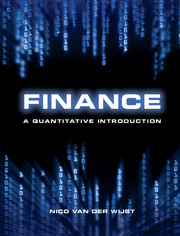Book contents
- Frontmatter
- Contents
- List of Figures
- List of Tables
- Acronyms
- Preface
- 1 Introduction
- 2 Fundamental concepts and techniques
- 3 Modern portfolio theory
- 4 Market efficiency
- Chapter 5 Capital structure and dividends
- 6 Valuing levered projects
- 7 Option pricing in discrete time
- 8 Option pricing in continuous time
- 9 Real options analysis
- 10 Selected option applications
- 11 Hedging
- 12 Agency problems and governance
- Solutions to exercises
- Glossary
- References
- Index
10 - Selected option applications
Published online by Cambridge University Press: 05 February 2013
- Frontmatter
- Contents
- List of Figures
- List of Tables
- Acronyms
- Preface
- 1 Introduction
- 2 Fundamental concepts and techniques
- 3 Modern portfolio theory
- 4 Market efficiency
- Chapter 5 Capital structure and dividends
- 6 Valuing levered projects
- 7 Option pricing in discrete time
- 8 Option pricing in continuous time
- 9 Real options analysis
- 10 Selected option applications
- 11 Hedging
- 12 Agency problems and governance
- Solutions to exercises
- Glossary
- References
- Index
Summary
Flexibility and option-like payoff structures are found in many decision problems in finance and an increasing number of them are analysed with option-pricing techniques. The results sometimes offer a new perspective on phenomena that are difficult to explain in the traditional DCF framework. In this chapter, we look at three such problems: the option nature of corporate securities, credit risk and mergers.
Corporate securities as options
Valuing debt and equity as options on the firm’s assets, as we did in the previous chapter, is one of the earliest applications of option pricing. Black and Scholes (1973) had already demonstrated the principle in their seminal paper and it was later analytically elaborated by Merton (1974). Analysing corporate securities as options profoundly changed our understanding of corporate decision making. We will present the application in simple examples, first with discrete, later with continuous time and variables. Along the way we will introduce another important concept in finance.
An example Consider a wealthy investor who has found two related but alternative project possibilities. They can be thought of as the technical development of a product idea in two alternative directions, each with its own market risk. Both projects require an investment of €36 million and will give an uncertain payoff with an expectation of €48.4 million two periods from now. The payoff of project 1 is estimated to have a present value of €40 million, but depending on market developments this value can either increase by 22 per cent or decrease by 18 per cent in each period. The real probability of an increase is 70 per cent. The payoff of project 2 is estimated to have a present value of €38 million, which is equally likely to either increase with 65 per cent or decrease with 39 per cent in each period. Lattice 25 gives the value dynamics for both projects.
- Type
- Chapter
- Information
- FinanceA Quantitative Introduction, pp. 285 - 307Publisher: Cambridge University PressPrint publication year: 2013



